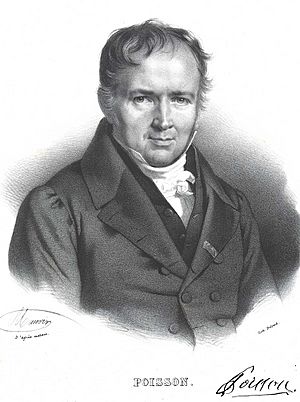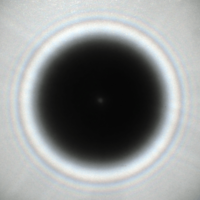Siméon Denis Poisson facts for kids
Quick facts for kids
Siméon Poisson
|
|
|---|---|
 |
|
| Born | 21 June 1781 |
| Died | 25 April 1840 (aged 58) |
| Alma mater | École Polytechnique |
| Known for | Poisson process Poisson equation Poisson kernel Poisson distribution Poisson bracket Poisson algebra Poisson regression Poisson summation formula Poisson's spot Poisson's ratio Poisson zeros Conway–Maxwell–Poisson distribution Euler–Poisson–Darboux equation |
| Scientific career | |
| Fields | Mathematics and physics |
| Institutions | École Polytechnique Bureau des Longitudes Faculté des sciences de Paris École de Saint-Cyr |
| Academic advisors | Joseph-Louis Lagrange Pierre-Simon Laplace |
| Doctoral students | Michel Chasles Joseph Liouville |
| Other notable students | Nicolas Léonard Sadi Carnot Peter Gustav Lejeune Dirichlet |
Siméon Denis Poisson (born June 21, 1781 – died April 25, 1840) was an important French mathematician and physicist. He worked on many different areas of science. These included statistics, electricity, magnetism, and how things move. He is also famous for predicting something called the Poisson spot. He did this while trying to prove another scientist's idea wrong, but it turned out he was right!
Contents
Biography
Siméon Poisson was born in a town called Pithiviers in France. His father was an officer in the French army.
In 1798, when he was 17, he joined the École Polytechnique in Paris. This was a very famous school. He was so good that his teachers let him study whatever he wanted. After less than two years, he published two important papers. These papers were so impressive that he was allowed to graduate in 1800 without taking the final exam. This was a huge honor for someone so young.
His success quickly opened doors for him in the world of science. Two famous mathematicians, Joseph Louis Lagrange and Pierre-Simon Laplace, became his mentors and friends. Poisson spent the rest of his life working on his many scientific papers and teaching.
Right after he finished his studies, he became a répétiteur (a kind of teaching assistant) at the École Polytechnique. His classmates often came to him for help after difficult lectures. In 1806, he became a full professor. He also held many other important positions. He became an astronomer and a professor of mechanics. He was also an examiner at military schools.
In 1817, he married Nancy de Bardi. They had four children together. Poisson was not very interested in politics. He focused mostly on his mathematics. He was given the title of "baron" in 1825, but he didn't use it. He was also elected to important scientific groups in England and America.
Poisson was known as a very successful teacher. He was also incredibly productive as a scientist. Even with many official duties, he published over 300 works. These included large books and many papers. They covered pure mathematics, applied mathematics, and physics. Another scientist, François Arago, once said that Poisson believed: "Life is good for only two things: doing mathematics and teaching it."
Poisson's most important work was applying mathematics to physics. His papers on electricity and magnetism were especially groundbreaking. They helped create a whole new area of mathematical physics. He also made big contributions to celestial mechanics, which is the study of how planets and stars move. He studied the stability of planetary orbits. This means he looked at how planets stay in their paths around the sun.
In 1837, Poisson was given a French peerage. This was a special honor to recognize his amazing scientific work. His name is also one of the 72 names written on the Eiffel Tower in Paris.
Contributions
Potential Theory
Poisson's Equation
Poisson is famous for an equation named after him: Poisson's equation. This equation helps describe how things like gravity or electric forces work. It shows how a "potential" (a way to describe the energy or force in a space) changes based on where matter or electric charge is located.
The equation looks like this:
Here,  stands for the potential.
stands for the potential.  stands for the density of matter or electric charge. If there's no matter or charge, the equation becomes Laplace's equation.
stands for the density of matter or electric charge. If there's no matter or charge, the equation becomes Laplace's equation.
Poisson's equation is used in many areas of physics. It helps scientists understand gravitation, electricity, and magnetism.
Electricity and Magnetism
By the end of the 1700s, people knew a lot about static electricity. Benjamin Franklin had talked about electric charge. Charles-Augustin de Coulomb had found his law about how electric forces work. In 1812, Poisson used the idea of a "potential function" to describe electricity. This function helps calculate the electric force from charged objects. His work inspired other scientists, like George Green.
In 1820, Hans Christian Ørsted showed that electricity could affect magnets. This led to a lot of new research. Poisson also studied magnetism. However, he thought electricity and magnetism were separate things. Later, Michael Faraday showed that electricity was more connected to matter itself.
Optics
Poisson was part of a group of scientists who believed light was made of tiny particles. They didn't believe in the wave theory of light. In 1818, a competition was held about how light bends around objects (called diffraction). A civil engineer named Augustin-Jean Fresnel submitted a paper explaining diffraction using the wave theory.
Poisson studied Fresnel's theory very carefully. He wanted to find a mistake in it. He thought he found one! Fresnel's theory predicted that if you shine light on a small circular object, there would be a bright spot in the very center of its shadow. Poisson thought this was impossible. He argued that the particle theory of light would predict complete darkness there.
However, the head of the committee, François Arago, decided to do the experiment. He used a small metal disk. To everyone's surprise, he saw the bright spot exactly where Fresnel's theory predicted it! This experiment proved that the wave model of light was correct. Fresnel won the competition. This bright spot is now known as the Arago spot or the Poisson spot.
Pure Mathematics and Statistics
In pure mathematics, Poisson worked on definite integrals. These are ways to calculate the total amount of something over a range. He also studied Fourier series, which are ways to break down complex waves or signals into simpler ones.
The Poisson distribution in probability theory is named after him. This is a very important tool in statistics. It helps predict how many times an event might happen in a fixed period of time or space. For example, it can predict how many phone calls a call center might get in an hour.
In 1820, Poisson was one of the first to study integrations using paths in the complex plane. This was a new and important area of mathematics. He also contributed to the divergence theorem, which is used in physics and engineering.
Mechanics
Analytical Mechanics
Poisson wrote an important book called Traité de mécanique (Treatise on Mechanics). This book was a standard text for many years. It helped shape how scientists understood how things move. He also worked on Poisson brackets, which are mathematical tools used to describe how physical systems change over time. These ideas were very important for later developments in physics, like quantum mechanics.
Continuum Mechanics and Fluid Flow
Poisson also made contributions to understanding how fluids (like water or air) move. In 1829, he independently found equations for how viscous fluids flow. These are now part of the Navier–Stokes equations. He also contributed to the theory of elasticity, which is about how materials deform under force.
Thermodynamics
Poisson also studied thermodynamics, which is the science of heat and energy. He worked on how heat spreads through materials. He also helped improve the formula for the speed of sound in air. He showed that the speed of sound depends on the specific heats of gases. He also found an important equation for gases changing under certain conditions.
Interaction with Évariste Galois
Poisson played a role in the life of another young mathematician, Évariste Galois. Galois was a brilliant but troubled young man. In 1831, Poisson reviewed Galois's work on the theory of equations. Poisson found Galois's work "incomprehensible" at first. However, he encouraged Galois to publish all of his work. Galois was in prison at the time. He later decided to publish his papers privately.
See also
 In Spanish: Siméon Denis Poisson para niños
In Spanish: Siméon Denis Poisson para niños
- List of things named after Siméon Denis Poisson
- Hamilton−Jacobi equation





